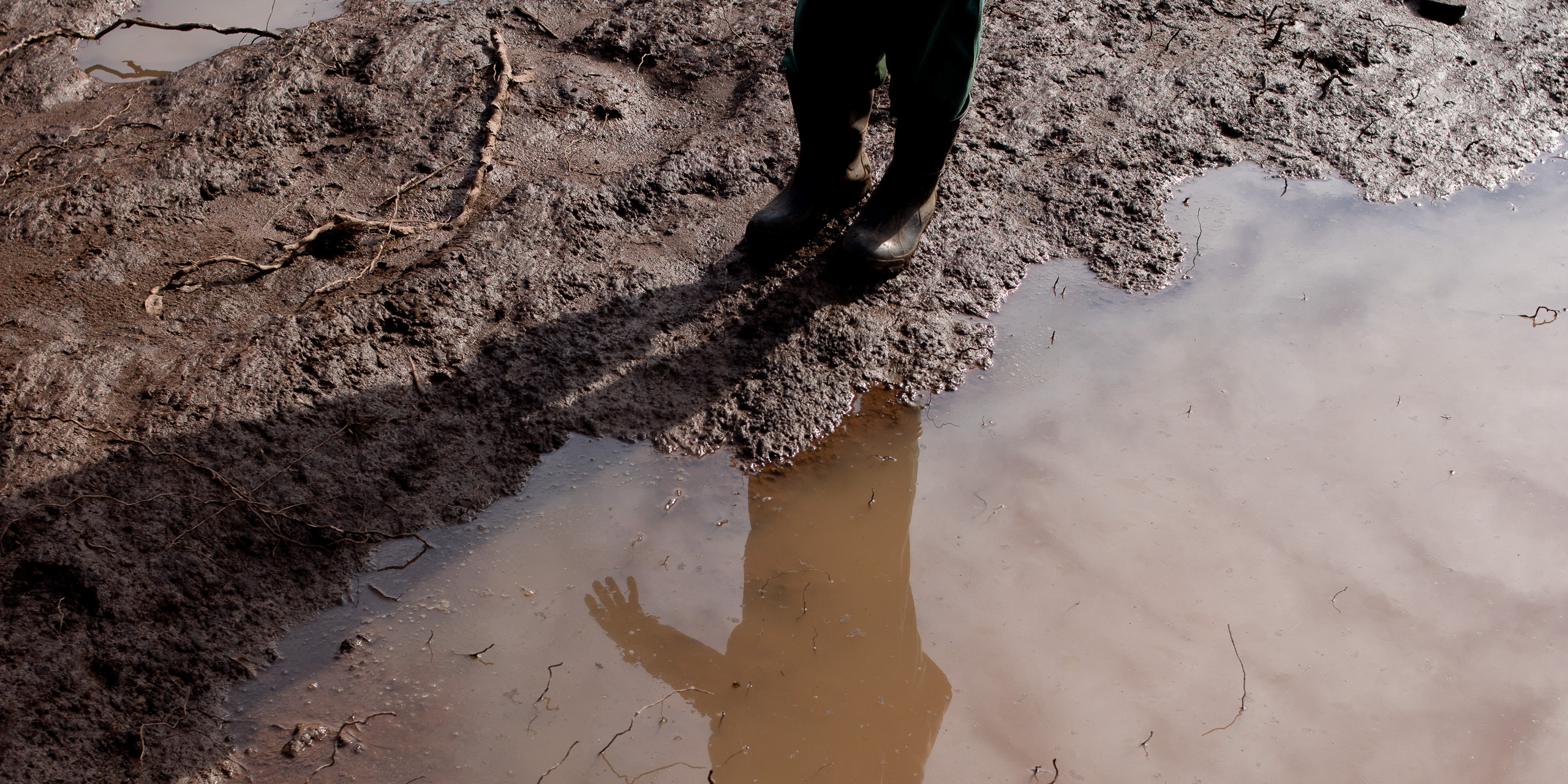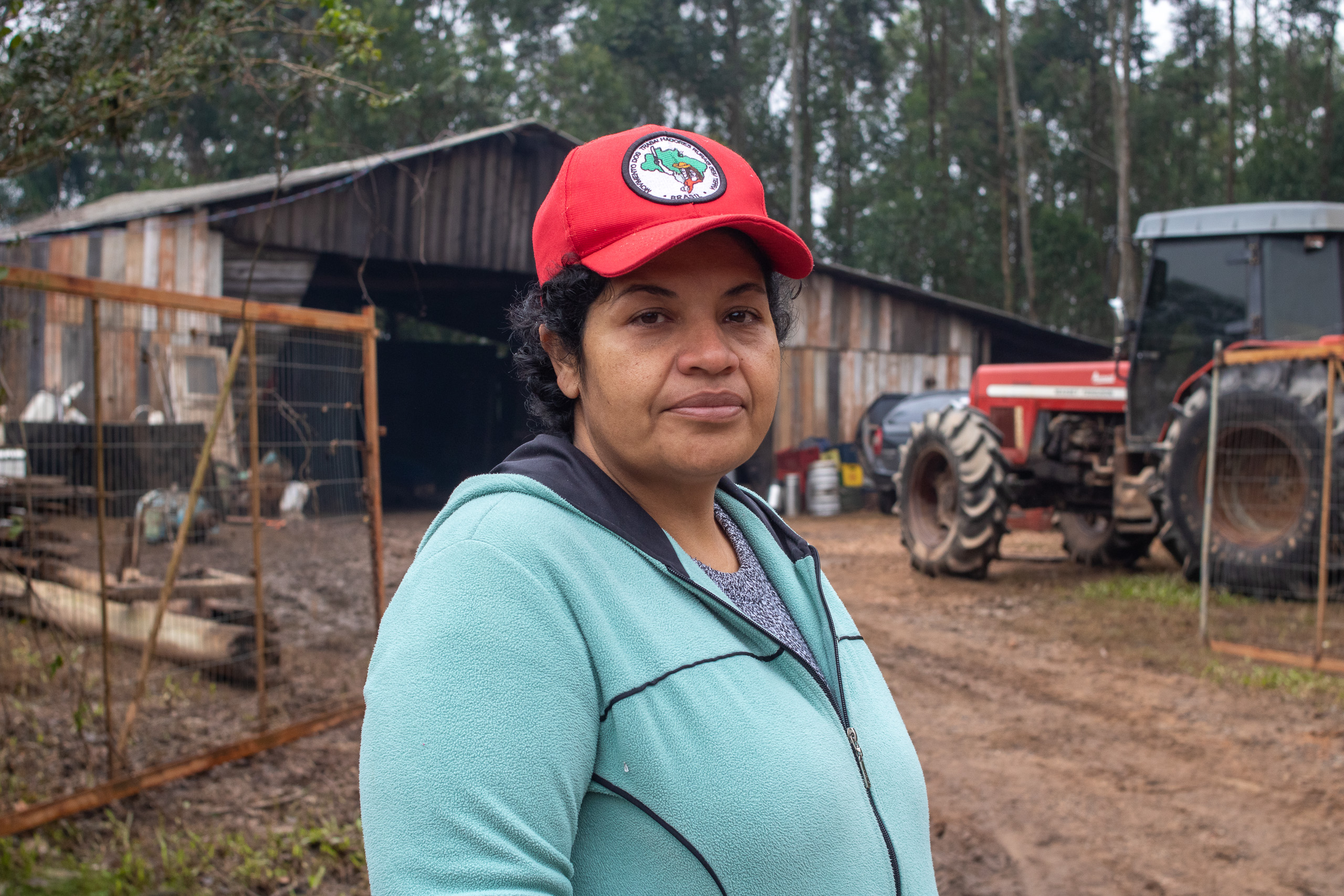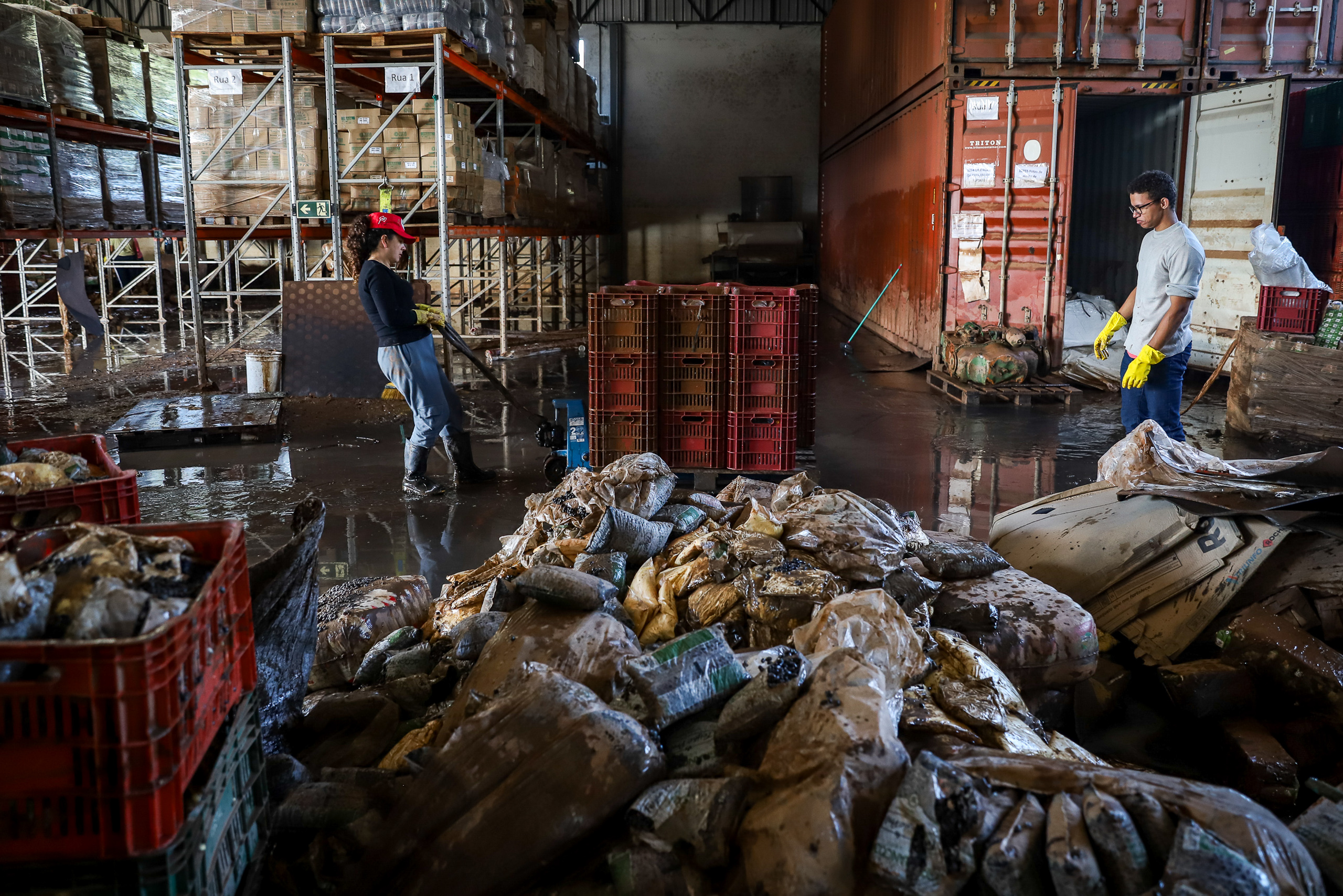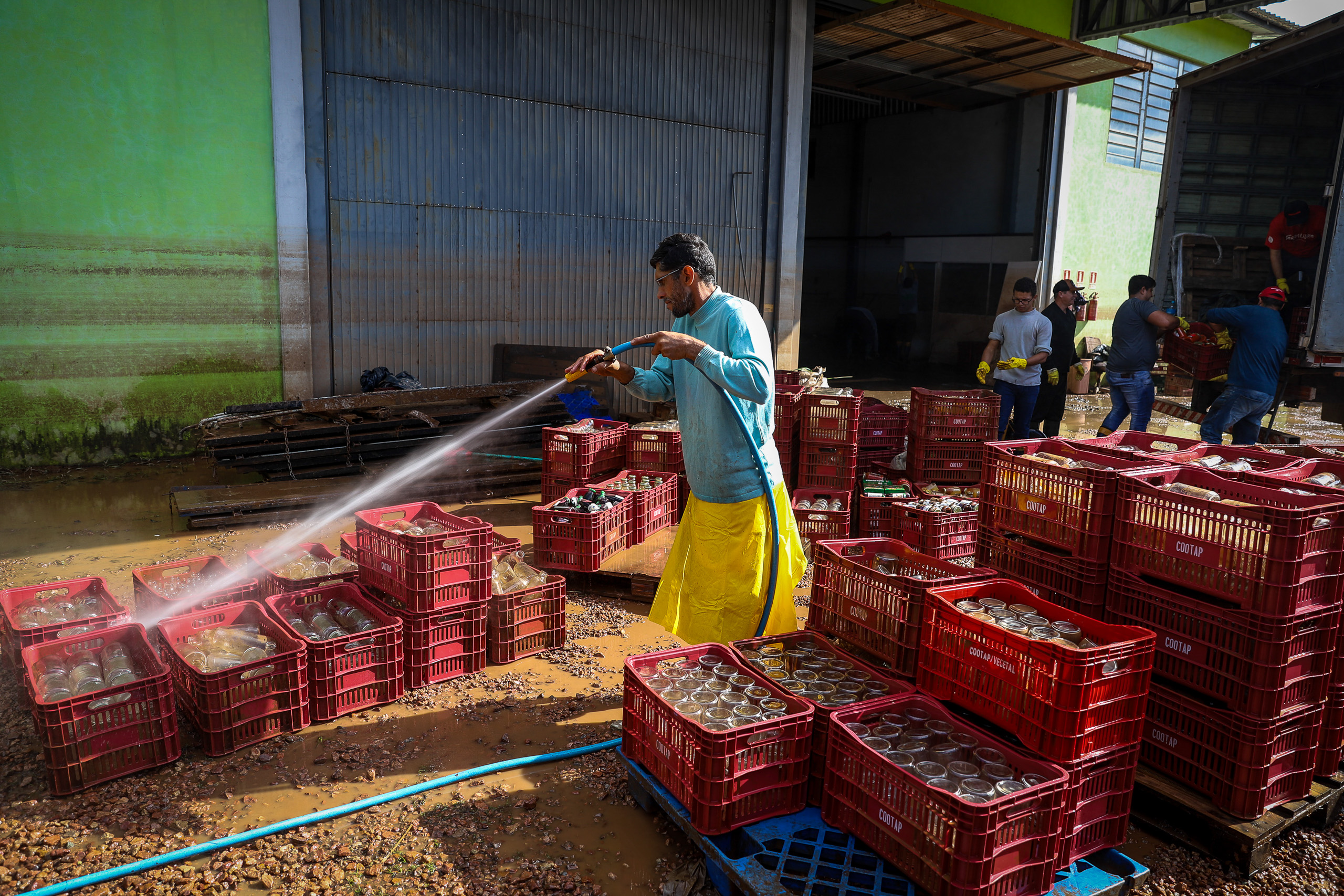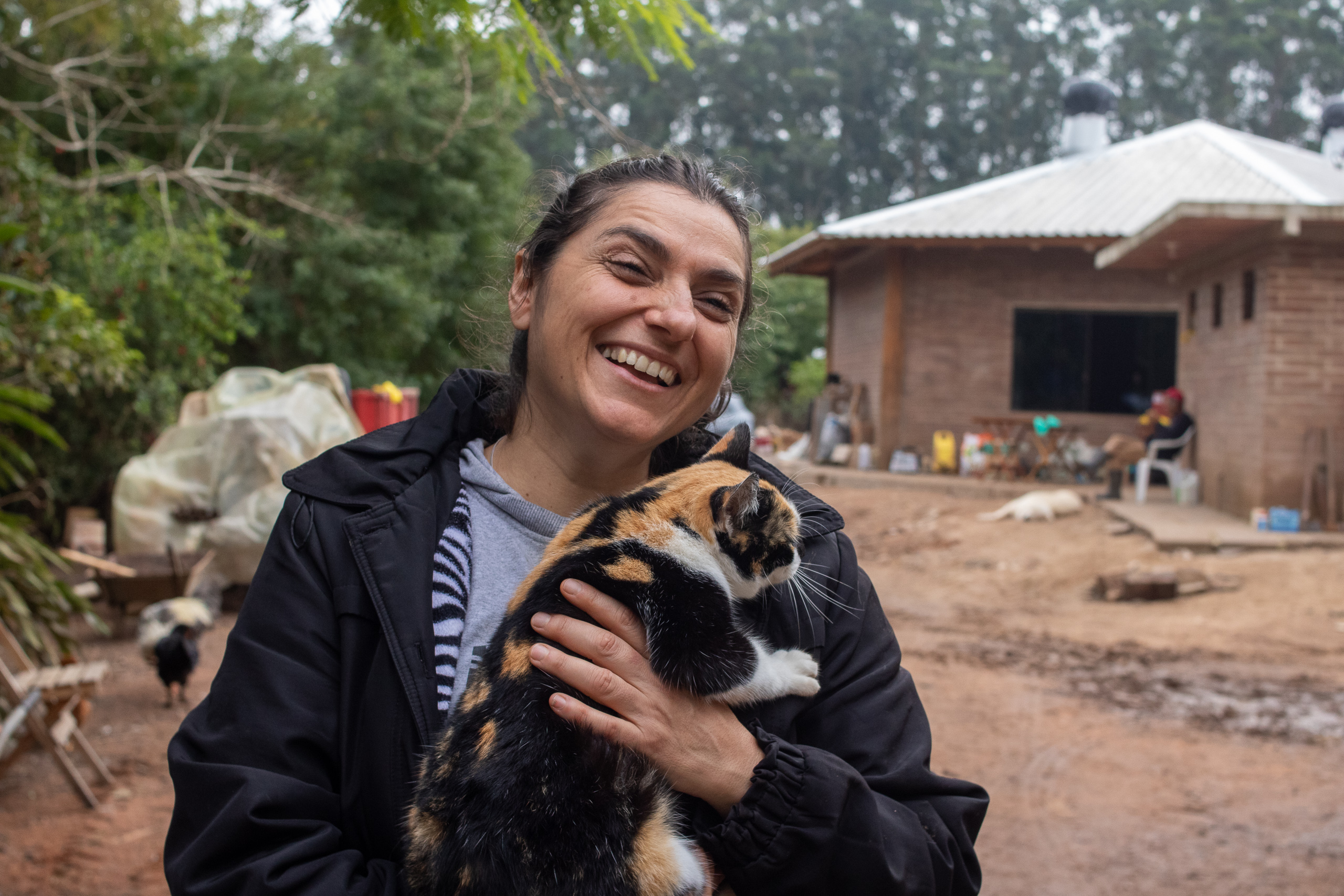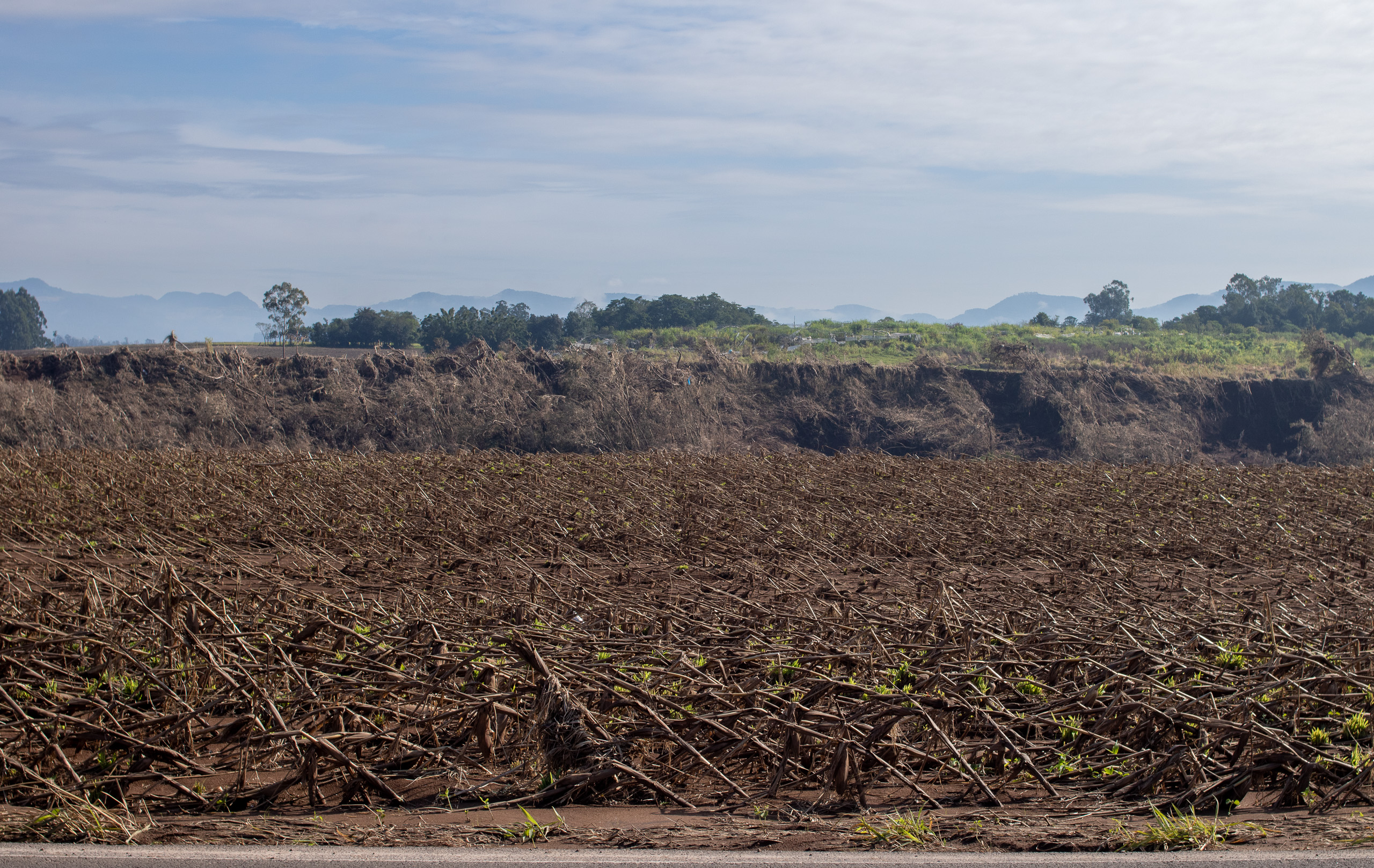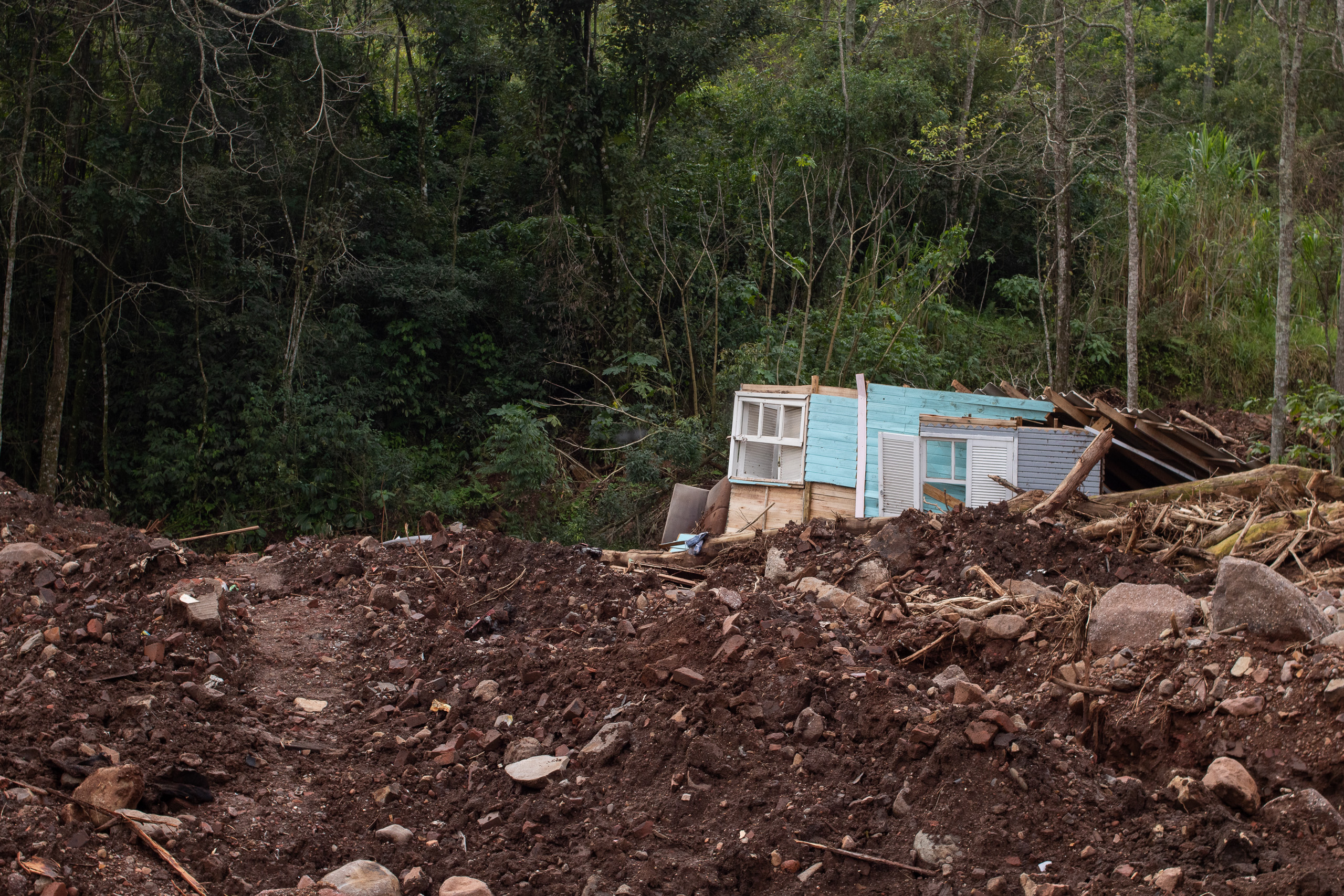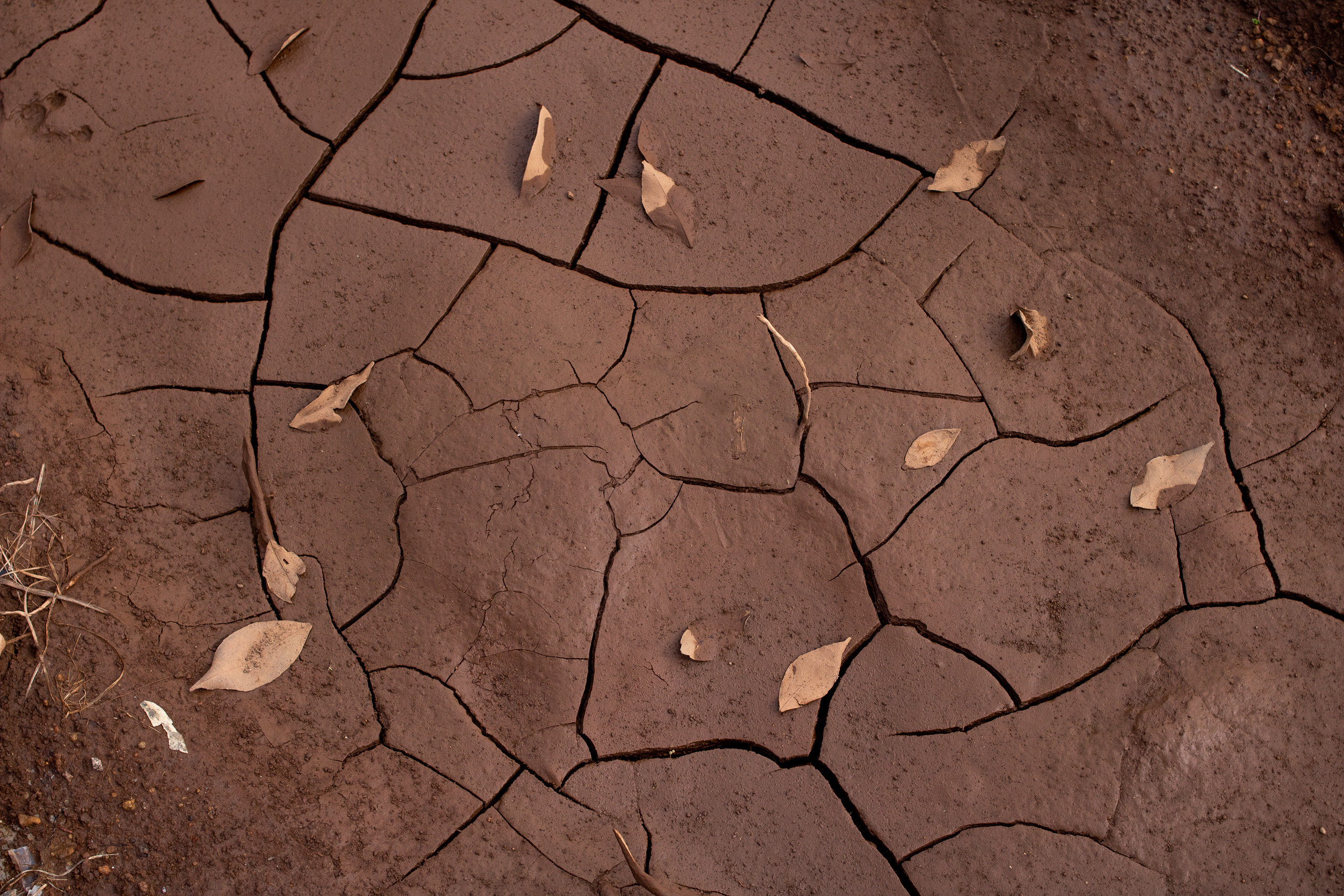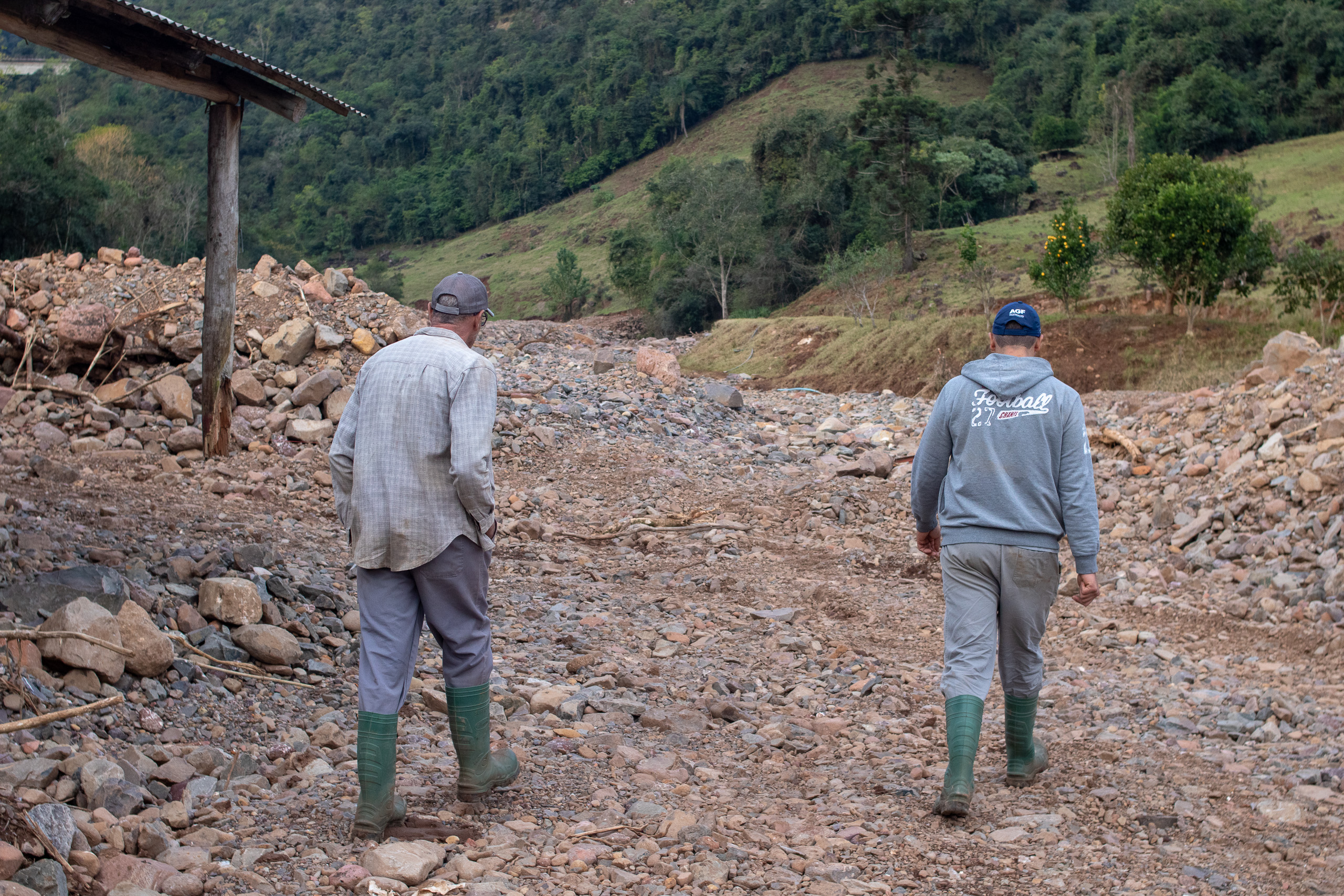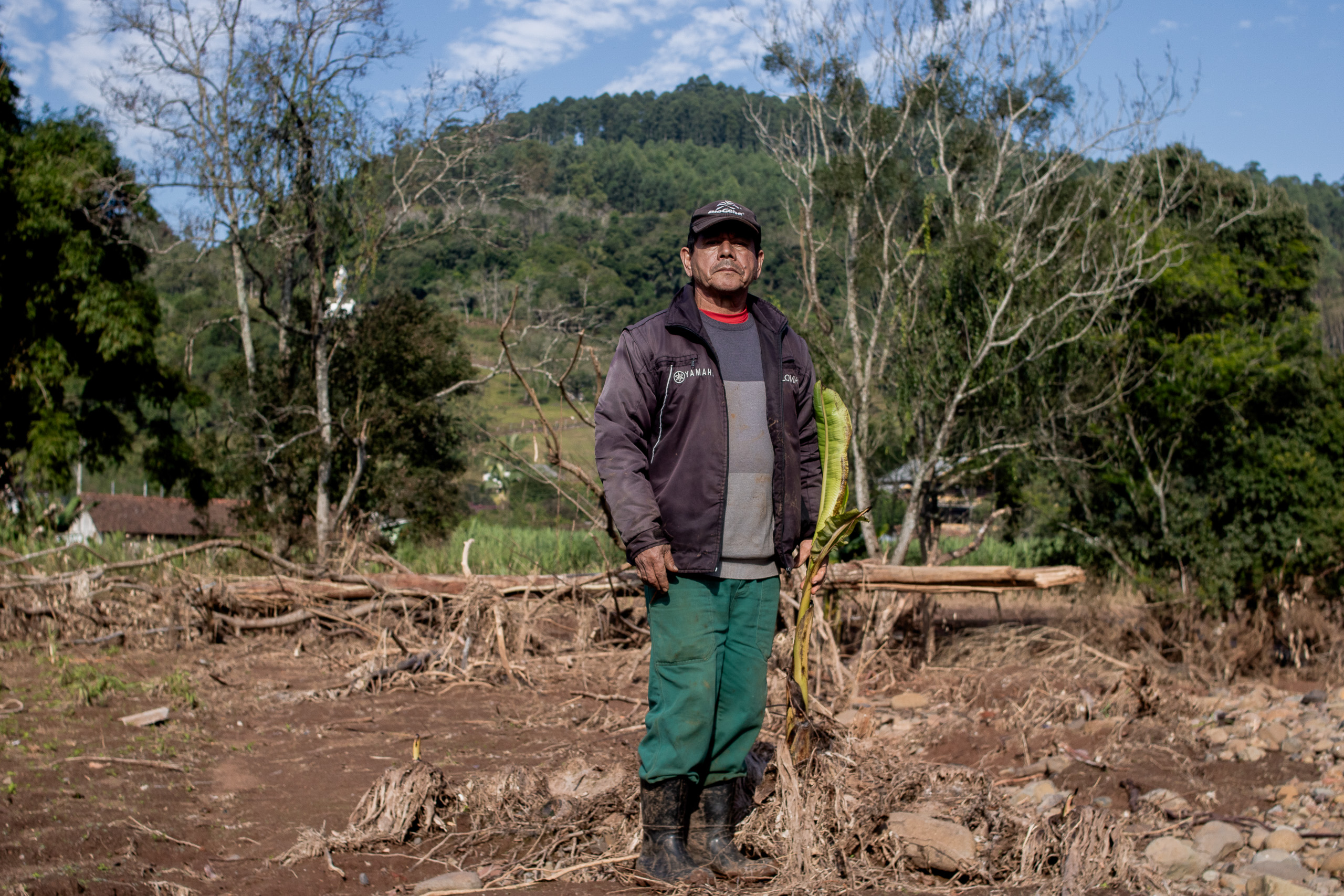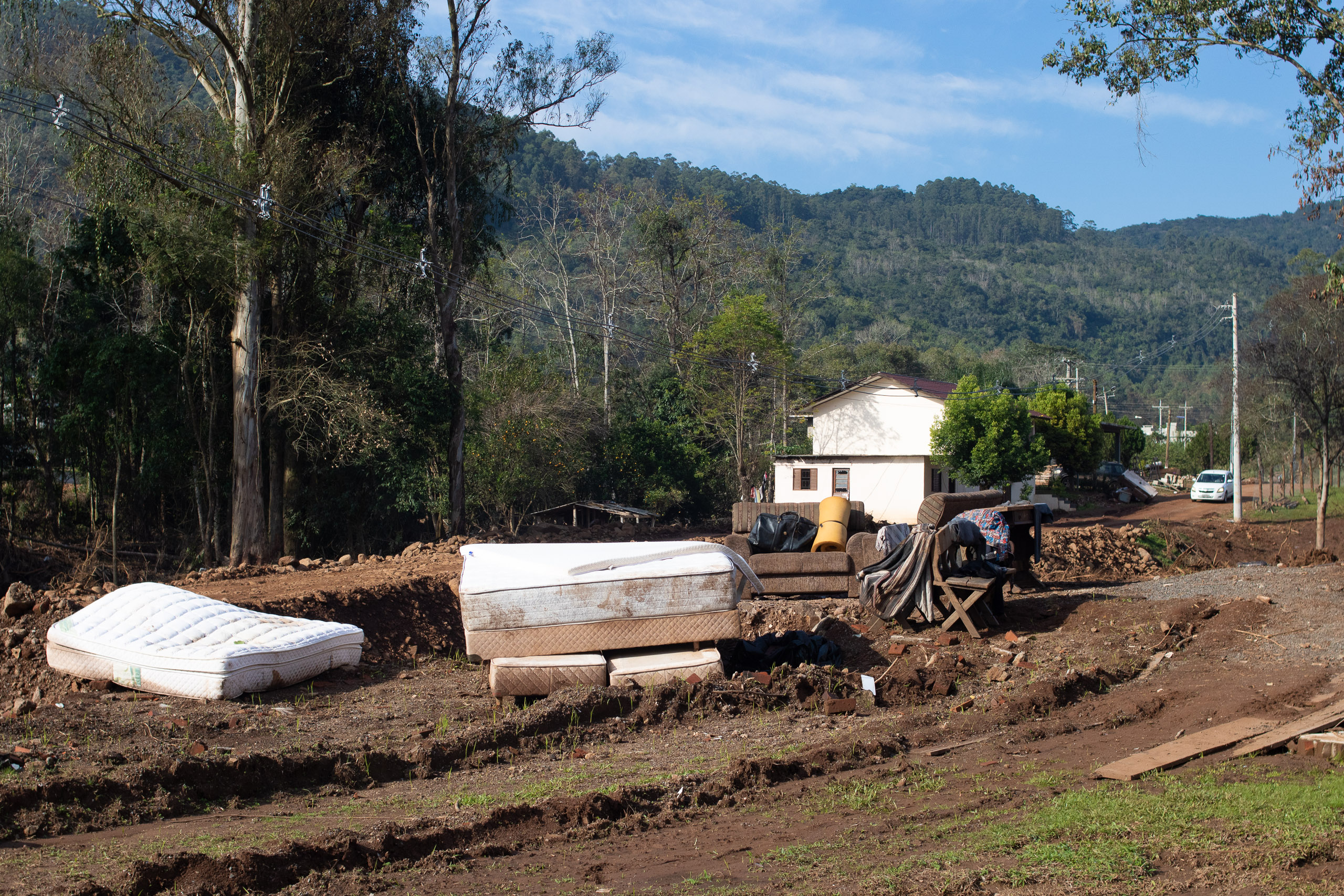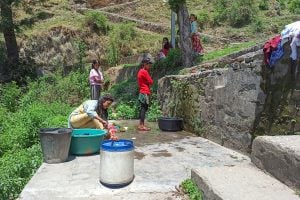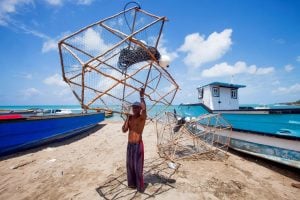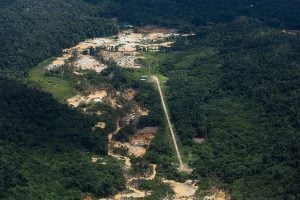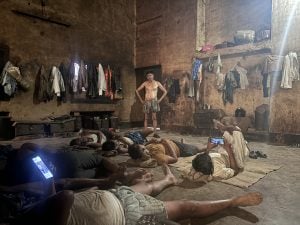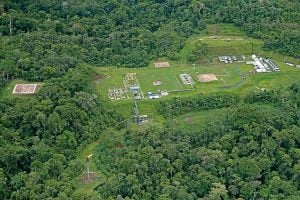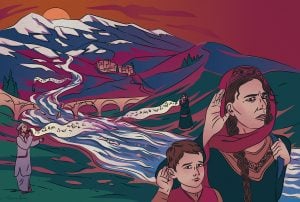It took 15 days before Roselei dos Santos Porto could muster the courage to return to her fields after they had been submerged by the floods that affected almost the entire state of Rio Grande do Sul in May.
The 44-year-old farmer had managed to return to her home in Eldorado do Sul, on the outskirts of Porto Alegre, the capital of Brazil’s most southernmost state. But she didn’t have the strength to set foot into what was now but a patch of compacted black earth, where just weeks earlier a colourful plantation of vegetables, legumes and tubers had stood.
When she decided to finally inspect her fields on Friday 1 June, accompanied by Dialogue Earth, Porto cried. “On Fridays, it was the day to fill the lorry with vegetables for the market,” she recalled.
The flood left no trace of her family’s organic plantation. But the elephant grass trees around the plot, about three metres high, bore the mark of the waters: only their tops remained green.
The floods were considered to be the worst environmental disaster in the history of Rio Grande do Sul. Torrential rains began at the end of April and persisted for almost a month and a half, causing rivers to overflow, hillsides to collapse, and flooding in cities situated on plains, especially in the Taquari Valley in the state’s interior, and in the Porto Alegre metropolitan area. By the beginning of July, there had been at least 180 deaths, with more than 30 people still missing.
The settlement Porto calls home is one of many across Brazil belonging to or occupied by the Landless Workers’ Movement (MST), an agrarian reform movement that is estimated to count more than 1.5 million members. In the Porto Alegre metropolitan area, the floods have reportedly led to more than 170 families in MST settlements losing their entire crop. The flooding of the Jacuí River, which flows through Eldorado do Sul, wiped out the facilities of one such workers’ cooperative, as well as machinery at Pão na Terra, an organic bakery that was founded in a settlement.
Across six affected MST settlements, more than 2,300 hectares of rice crops were destroyed, totalling more than BRL 10 million (USD 1.8 million) in damage, according to preliminary figures from the MST.
One of Brazil’s largest agricultural producers and its leading rice producer, Rio Grande do Sul has been on the frontline of climate crisis in recent years: this is the seventh extreme event since 2020. Long spells of drought in three successive years have each been followed by floods, which have together created seriously challenging conditions for agriculture.
But the impacts have been felt for even longer in the state. “Every four years since 2005, we’ve had to start all over again,” said Marcia Riva, one of the founders of Pão na Terra. As well as seeing her company’s kitchen flooded, Riva lost her own crop of shimeji mushrooms.
Research has suggested that climate change may be leading to stronger El Niño and La Niña events, the weather patterns that arise as a result of changes in Pacific Ocean temperatures – recent episodes which have brought devastating effects in Rio Grande do Sul. A recent study by researchers from five countries shows that global warming has also doubled the chances of heavy rainfall in a short space of time in the state.
The severe droughts of 2020 to 2023 were influenced by La Niña, which also affected neighbouring Argentina and Uruguay. Last year, with the arrival of the El Niño pattern, there were three floods: in June, September and November, which left more than 70 people dead, mostly in the Taquari and Caí valleys, also in the centre of Rio Grande do Sul.
Farmers reluctant to quit
Across three days, Dialogue Earth travelled through five cities in the state of Rio Grande do Sul to understand the impacts of climate extremes on small producers. Despite the most recent shock, most say that they do not want to give up on farming, but are hoping for increased support to continue working on the land.
A proposed bill to extend the repayment deadlines on loans held by producers affected by the floods is currently under discussion in the national congress. In addition, the Ministry of Agrarian Development has announced a BRL 600 million (USD 110 million) fund for victims to access federal credit lines.
On 3 July, the federal government also announced incentives for rural producers, as it does every year with its annual agricultural plan, the Safra Plan. But this time saw more than BRL 400 billion (USD 73 million) earmarked for the country’s large and medium-sized producers, almost four times more than to family-run farms, which will receive BRL 86 billion (USD 15.8 billion).
“To no one’s surprise, the amount allocated to family farming remains hugely unequal to that allocated to agribusiness. It’s not fair,” said Mariana Campos, Greenpeace Brazil’s agroecology coordinator, in a statement released in response to the plan.
The floods affected 56% of the 365,000 rural properties in Rio Grande do Sul. Emater, the federal agency for rural technical assistance, has highlighted how the damage has been most pronounced in areas where family farming predominates, such as the Porto Alegre metropolitan region and the Taquari and Caí valleys.
However, the federal government’s measures may not be enough to rebuild agriculture in Rio Grande do Sul, which is already facing an intense rural exodus and the retirement of its workforce. It is reported that more than half of all farms in the state are run by people aged 55 or over.
Agricultural censuses show that family farming is already losing ground. The number of small properties in this sector fell from around 378,000 in 2006 to 294,000 in 2017, the most recent survey, representing a 22% drop.
“Without a public policy of debt forgiveness and financing with an [extension of the grace period] and low interest rates, many will not return to production, nor will there be a stimulus to succession,” said forestry engineer Ernestino Guarino, a researcher at Embrapa, a federal government agency focused on agricultural innovation.
Embrapa has created a platform to estimate the impacts and propose a new model of agriculture that is more resilient to the climate. But Guarino says that “the next few months will be decisive” as to whether the activity will lose even more ground, and this will depend on what actions are taken.
There is a consensus among the experts interviewed by Dialogue Earth that there is a need to correct funding inequalities between small and large producers, who have easier access to credit, to encourage the recovery of degraded areas and the adoption of sustainable practices, as well as to strengthen support agencies such as Emater and Embrapa. Without this combination, they say, producers will not recover from this latest setback.
“There needs to be a push for a new agro-ecological production model, with respect for environmental legislation, which financially rewards the farmer who preserves,” said Sérgio Schneider, professor of postgraduate studies in rural development at the Federal University of Rio Grande do Sul (UFRGS) and a consultant for the Food and Agriculture Organisation of the United Nations.
Agronomist Pedro Selbach, a professor in the soils department at UFRGS, together with colleagues from the university, estimated losses of BRL 19.4 billion (USD 3.5 billion) as the immediate impact of the 2024 floods on family farming, due to the loss of crops and output. The impacts of losses in soil fertility were estimated at more than BRL 6 billion (USD 1.1 billion), with such changes likely to have more lasting and damaging effects in the long term.
“There was severe damage to the physical, chemical and biological characteristics of the soils,” said Selbach, explaining that the force of the downpour took away their arable layer or completely modified their properties in areas that were flooded for weeks. “Many areas that were arable are now no longer arable, some may take 400 years to recover.”
A survey by Cleberton Bianchini, of the Pro-Riparian Forest Movement of the Taquari Valley, has shown an intense destruction of permanent preservation areas (APPs), which protect vegetation near watercourses under national law. More than half of the APPs on the banks of 140 kilometres of the Taquari River, which cuts through the region, have reportedly been converted into pastures, plantations or urban infrastructure – in some cases, before the protection was incorporated in 2012.
In addition, from 1985 to 2022, the state lost 22% of its native vegetation, and a third of this destruction occurred in the basin of the Guaíba lake, upon which Porto Alegre sits, and which stretches southward over several cities. In the same period, soy production, forestry and the urbanised area all increased.
A preliminary survey by Selbach and colleagues assessed the relationship between deforestation and flooding. If the banks of the Guaíba lake had been preserved, the study estimates that river levels would have been as much as 1.5 metres lower, which could have prevented the recent flooding of Porto Alegre, where half of all neighbourhoods were submerged.
Mud and rock cover fields
In Muçum, in the Taquari Valley, the unprecedented overflow of the Guaporé River devastated the property of the Canal family, who have been growing hay for over 40 years. The 748 millimetres of rain in three days at the end of April, more than five times the average for the whole month, caused rocks to slide down from the hills, covering a dam and part of the family’s pasture. “If there were no rocks, it would be mud,” said Ezequiel Canal, 32, pointing to his buried field.
The downpour washed away 340 bails of hay, representing a loss of BRL 165,000 (USD 30,000) for the family. Ironically, it ripped out their underground irrigation system, imported from Israel for BRL 250,000 (USD 46,000) to guard against drought, but which was never used. “During the drought, we spent three years earning 40% less each year,” Ezequiel said.
Adair José Villa, president of the Muçum Rural Workers’ Union, adds: “One day of flooding has spoilt more than three years of drought.”
Standing on the rocks, next to an aluminium shed with a roof twisted by the torrent, Ezequiel and his father Izair, 65, say they plan to leave their land. “You can survive one flood, but not three,” said Izair, who experienced his first flood less than a year ago. This time, he and his wife, Ana, took refuge inside the backhoe of a digger for a day and a half awaiting rescue, while they watched their property being submerged.
Around 15 kilometres south of Muçum, the municipality of Encantado also suffered from the overflow of streams like the Jacarezinho, which isolated a rural community occupied by small dairy and pig farmers.
Mauro Vieira Marques, 65, lost two dairy cows, two bullocks and 150 chickens and young hens, swept away by the current. Of all his stock, only one cow remained.
The farmer and his wife, Ivete Justina, ran a half-hectare property where they produced artisan cheeses and eggs, as well as growing fruit and vegetables. “There aren’t even any fruit trees left,” said Mauro, looking out over a bare field.
When we met, Mauro was standing amidst the rubble of what was left of two small sheds, which housed freezers for storing cheese, a milk drum and an aviary. “This used to be a paradise, now it looks like a bomb went off,” he added.
The couple’s two children live far away. “They insist that we leave, but our life is here,” he said. Mauro and Ivete intend to rebuild their house on higher ground and start again slowly, although they are still heartbroken. “How can we stay if the river doesn’t even have a bed anymore?” he said, looking at a stream that now sprawls shapelessly over a flooded area.
Three kilometres from the couple’s property, the Gonzatti family felt the effects of the flood despite living higher up in the hills. The landslides spared their more than 1,100 pigs, but isolated their property for 18 days, leaving it without electricity or water. The situation forced brothers Josué and Jonathan to walk four kilometres a day to feed the animals with the little feed they had left.
The Lorenzon family, who have been pig farmers for three generations, also suffered losses. The flood hit just as they were loading pigs onto a lorry for slaughter, and a collapsed barrier prevented transport. There was also no way to buy more feed, and there was little in stock. “We had to ration the feed, and we lost 13 animals [to starvation],” said Gustavo Lorenzon.
Since deciding to follow the family tradition in 2021, 37-year-old Lorenzon has suffered from droughts and floods, as well as the high price of grains used for pig feed. The Covid-19 pandemic, impacts from the war in Ukraine and droughts have caused the price of corn to temporarily double, and soy to rise by 60%.
“We want to stay in the business, it’s our vocation, but we’re very much at the mercy of the weather,” said the pig farmer.
By mid-June, some producers were still unable to return to their homes, which remained flooded. This was the case for Vanusa and Isaías Kaiper, fishers and residents of the Arquipélago neighbourhood in the greater Porto Alegre area. They had gone two months without fishing in Lake Guaíba. “The fish are contaminated from eating dead animals and rubbish,” Isaías told Dialoge Earth in June. “We can’t fish now, we have to wait.”
Even so, the floods do not worry him as much as the drought, which in 2022 caused the fish to disappear. “We had to buy fish to resell,” he explained.
But the couple are not thinking of giving up, despite the adverse weather conditions. “Our life is here, we raised our daughters on fishing and we’re going to carry on,” said Vanusa.
Insurance claims are piling up
On one of the tables at the Emater office in Encantado, an in-tray of papers almost a metre deep reveals the size of the problem of continuing farming: these are cases for Proagro, a kind of insurance issued by the federal government to suspend financial obligations in the event of extreme weather.
“Until 2013, farmers in the region didn’t even know what Proagro was,” says agronomist Eduardo Mariotti Gonçalves, who is responsible for providing technical assistance to 300 rural properties in the municipality. Now, he says, they “can hardly cope” with the number of requests and inspections to obtain insurance.
To be eligible for Proagro, producers need to plant according to the Agricultural Zoning for Climate Risk (Zarc), a federal government mapping guideline that indicates risks and the appropriate crops for each area. If a producer plants outside the Zarc limits, they are not entitled to insurance. But Gonçalves was particularly concerned about the supply of insurance after so many disasters.
After the floods in May, Rio Grande do Sul is projected to face a drier second half of the year, with the expected arrival of another La Niña period. But the risk of flooding could return at the turn of 2025, according to the National Centre for Monitoring and Alerts on Natural Disasters. “More than ever, farmers will need to make their decisions based on the climate,” said Pedro Selbach.
Yasmmin Ferreira also contributed to this report.
